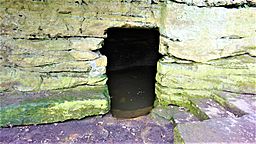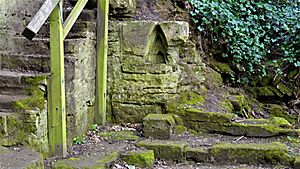St Robert's Cave and Chapel of the Holy Cross facts for kids
Quick facts for kids St Robert's Cave and the Chapel of the Holy Cross |
|
|---|---|
| St Robert's Chapel and the Chapel of the Holy Rood | |

The entrance to St Robert's Cave
|
|
| Location | Knaresborough, North Yorkshire |
| OS grid | SE351564 |
| Entrances | 1 |
| Hazards | Caution required. |
| Access | By a steps and a path |
St Robert's Cave and the Chapel of the Holy Cross are ancient sites in Knaresborough, North Yorkshire. They are found on Abbey Road, right next to the River Nidd. These places are special because they show us what a medieval hermitage looked like. A hermitage is a place where a hermit, a person who lives alone for religious reasons, would stay.
The cave and chapel were carved out of the rock along the river. They include a living area for the hermit and a chapel. The chapel was originally where St Robert was buried. Today, monks from Ampleforth Abbey look after the site. In 1989, the Harrogate Museums Service cleaned up the area and did some digging to learn more about it.
Contents
Who Was Robert of Knaresborough?
Robert of Knaresborough was born Robert Flower in York. His family was wealthy. From a young age, he wanted to live a religious life. After a short time in a traditional abbey, he decided to become a hermit. He spent most of his life living in a cave by the River Nidd in Knaresborough.
Even though he was never officially made a saint by the church, people saw him as one. In 1252, the Roman Catholic Church recognized him as a saint. So, we call him 'St Robert'. St Robert died on September 24, 1218. He was first buried in the chapel. Later, his body was moved to the Trinitarian Priory nearby.
A Unique Medieval Hermitage
There are records of about 500 hermitages from the past, but we don't know where most of them were. St Robert's Cave is very special because it's one of the few surviving examples of a medieval hermitage. It even includes the area where the hermit lived. The combination of St Robert's Cave and the Chapel of the Holy Cross is truly one of a kind.
History of the Site
The land for the cave and chapel was given to St Robert by William de Stuteville. He was in charge of Knaresborough Castle. It's said that King John visited St Robert at the cave. In 1216, King John gave St Robert 40 acres of land. Some people even believe the first Royal Maundy ceremony happened here. This is a special event where the monarch gives money to people.
The chapel is called the Chapel of the Holy Cross. It's a Grade II Listed Building, which means it's an important historic place. You can reach it by a narrow path and steps from Abbey Road. Sometimes, this chapel has been confused with another nearby chapel, the Chapel of Our Lady of the Crag.
Exploring St Robert's Cave
Because St Robert was so famous and people reported miracles, the cave and chapel were very popular. Many people visited them before the Reformation. The Reformation was a big change in the church in the 1500s. The cave was also sometimes called Saint Giles' Chapel or priory.
Inside the cave, there's a bench and steps carved into the rock. The entrance to the cave is between them. More steps lead to the floor of the cave, which is also cut from the rock. The bench outside is carved into the cliff face, offering shelter.
The cave has two main parts. One was for living, and the other was for religious use. There's an alcove and another bench carved into the back of the second room. The cave is shaped like an 'L'. It's almost 4 meters long from east to west and 3 meters wide from north to south. The second part was St Robert's living area. The walls and ceiling of the cave, which are about 2.2 meters high, have many carved spaces and initials. You can even see an old cross carved there, possibly from the 1100s. Clear tool marks show that the cave wasn't entirely natural. Records say St Robert himself worked to make the cave bigger.
The cave and chapel have often flooded from the River Nidd. This happened even though there was an old drain on the site. We don't know much about what happened to the cave after the Reformation. However, there are hollows in the cliff wall. These suggest that simple shelters might have been built against the cliff at one time, similar to the nearby Chapel of Our Lady of the Crag.
The Chapel of the Holy Cross
St Robert's brother, Walter Flower, was the Mayor of York. He wanted to help his famous brother. So, he paid for stonemasons to build a shelter. This shelter was a place where St Robert could meet with poor people and pilgrims. Walter also paid for a chapel to be built. It was dedicated to the Holy Cross or Holy Rood.
We don't have clear dates from the chapel's features. The foundations of the rectangular chapel building show a grave space. This grave was cut out of the floor in front of where the altar used to be. The grave is 2 meters long and between 0.35 to 0.53 meters wide. Its sides were cut so that a covering stone could lie flat with the floor. This was a common way to bury important people back then.
A few layers of carved stones remain on the south and east sides. However, nothing is left above ground on the west side. The Trinitarian Order, a religious group, later took over the chapel and cave. They reburied St Robert at their nearby priory. This priory was called the Priory of the Holy Trinity and St Robert. It was founded before 1252. The Scots attacked the priory in 1318, and it was closed down in 1538.
Visiting St Robert's Cave Today
The cave was once a popular place for religious journeys. Today, it is still open for people to visit.




